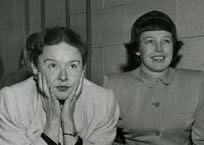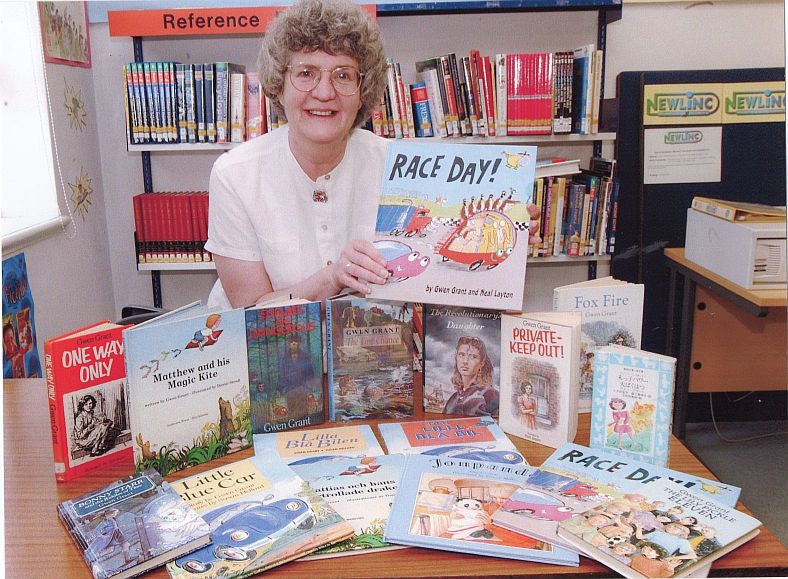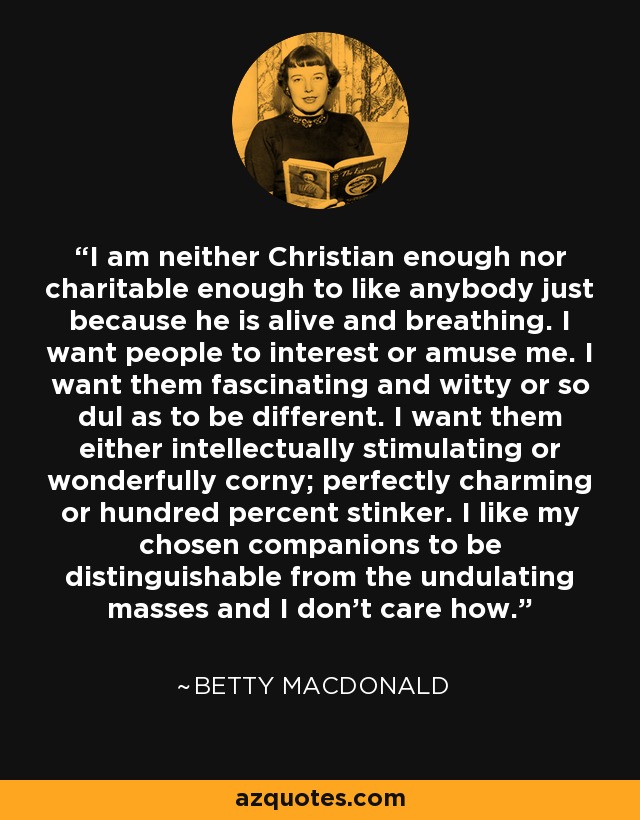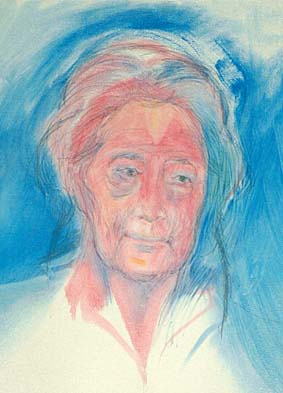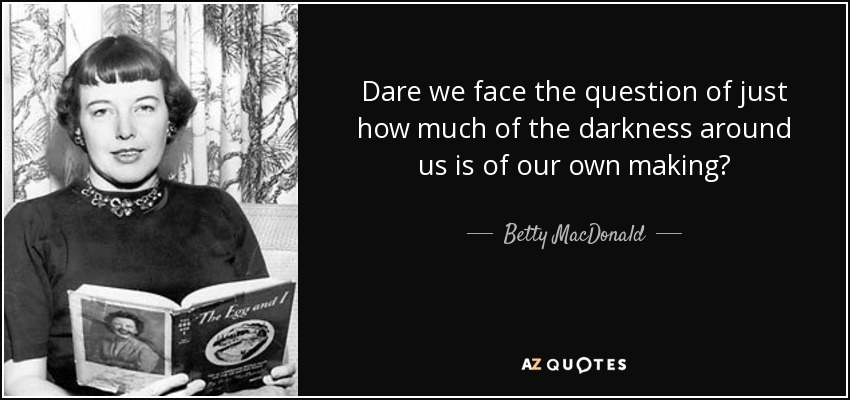



Mary Bard Jensen - and Betty MacDonald fan club fans,
we received this mail from our Betty MacDonald fan club honor member Gwen Grant, beloved author and Betty MacDonald fan.
I agree we have the most interesting and fascinating Betty MacDonald fan club honor members.
Betty MacDonald fan club fans from all over the world enjoy reading Gwen Grant's wonderful books.
Ina
Dear Betty MacDonald fan club fans,
i've just taken down from my bookshelves the four books of Betty's that I have and they've been read so much, the covers of THE EGG AND I and ONIONS IN THE STEW are a a bit battered! I was interested in the dates they were published and thought others might be interested, as well.
THE EGG AND I - 1955 - llth impression
THE PLAGUE AND I - 1949
ANYBODY CAN DO ANYTHING - 1951
ONIONS IN THE STEW - Not dated
and 'WHO, ME?' 1960 - a compilation of Betty's work and this has a small photograph of Betty on the cover of the book itself and inside there is a photograph of Betty and two of her grandchildren.
Three of them are Book Club books and they look nothing from the outside - give no idea of the brilliant world within. Opening one of Betty's books is like finding treasure. The 1949 and 1951 books I bought at a Jumble Sale when I was about 17 and had read THE EGG AND I. I felt so fortunate to find them and carried them home as tenderly as if they were eggs! I think they were printed on wartime paper because the paper isn't spectacular. I imagine, though, that there are much older books than these around and just as much loved as mine.
Another fan of Betty's asked recently how old I was when I first read Betty's books - I think I was about 16. I read THE EGG AND I first because from the moment I read that first paragraph, I was hooked. I loved reading about people's lives and that opening paragraph is so instantly appealing.
My own books were much influenced by Betty, especially KNOCK AND WAIT, which is the story of my year at an Open Air School, which was a bit like a Sanatorium but wasn't.
PRIVATE-KEEP OUT is the first in my trilogy dealing with my childhood. There are fictional elements to this book but the basis is true.
My family, for instance, at that time was my three brothers but I had a sister who died. All the same, I thought of her as still being my family, so I put her in my book as Lucy. I have another sister younger than me - so the heroine had two sisters, but, I have to say, all the nice parts of Rose are my youngest sister's - all the other bits are me! The town I lived in is there, the street I lived in, the feelings I had, many of the things that happened.
KNOCK AND WAIT - When I first wrote this book, it wasn't at all funny, and I wasn't happy with it. It sounded too sad and too dark, so, remembering THE PLAGUE AND I and Betty and Kimi's response to their situation, I rewrote KNOCK AND WAIT and this time I was happy with it. It was funny and yet it showed the truth of my year in that hsopital school. Betty walks a tightrope with THE PLAGUE AND I because to write about something so life changing as a serious illness and yet keep it light but without minimising the impact it has on your life or belittling the experience, because, of course, there are others who suffer as well, is tremendously difficult. Betty had that unique ability and I think that ability came from the generosity of her nature.
ONE WAY ONLY - there are fictional elements in this book but still mixed with many elements of truth.
I have written other children's books about subjects that have been important to me and these will eventually appear on my website which is still being built. I wish I could say I was building it but it's my husband, Ian, (a Scot) who is actually doing the work. When my is finished, all my books will be on it and more of my poems.
I have written four picture books - LITTLE BLUE CAR, which is about a new little car learning how he works - just like all small children. This was a story I used to tell my grandchildren. Their father had a little blue car so I just brought the car to life - helped by the children's fondness for it.
JONPANDA - about a Panda. I have that Panda still. I had him when I was a little girl and now he's so old and battered, he lives in tissue paper in a paper bag in the cupboard. JONPANDA comes to life for his friend, Mamie, who has rescued him from a wretched life at the fairground and they share a challenging experience together.
MATTHEW AND HIS MAGIC KITE - a story of a little boy's adventure on a kite that turns out to be magic. He goes to the North Pole on the kite because I always loved the idea of the North Pole, and has an adventure with a bear. Now this bear was one that used to be in Dundee, Scotland, museum and we lived there for a year. I used to take my sons to look at it but my imagination was captured by this bear and I looked at it as much as the boys. I once stepped over the rail that said 'KEEP OUT' and touched its fur and it was hard and spiky. Poor bear.
RACE DAY- this is a story about all kinds of vehicles competing in a race - but it's also about Littel Red Bubble car being kind to animals and to the other vehicles in the race. I guess I just wanted to highlight how so very often kindess and competitiveness go hand in hand.
At the moment, I'm working on a book called THE LAST COAL BARGE. I live in a village that used to have a coal mine at its heart. That's gone now but in its place there is a marina. However, there is a history in the old pit area and Danny meets part of it when he meets the mysterious Jarred Turner, his pony, Boxer and his pet blackbird, Casey. It tells of the fate of the last coal barge lying in the deep water of the pit.
PRIVATE-KEEP OUT can be ordered from Amazon but the other books have to be sought out.
I hope many of you will read my stories and enjoy them.
Love,
Gwen Grant
i know November wasn't Betty MacDonald's favourite month but we don't have typical November weather.
Even the roses are still blooming.
Speaking about favourites we would like to hear your opinion.
Which one is your favouite book by Betty MacDonald?
Let us know and tell us the reason why, please.
Deadline: November 30, 2016
You can win very new interesting Betty MacDonald fan club items.
Good luck!
I adore Betty MacDonald's books very much.
I guess The Plague and I is my favourite because of Betty MacDonald's wonderful friend described as Kimi in The Plague and I.
Everybody knows that Kimi is Monica Sone, author of Nisei Daughter and our first Betty MacDonald fan club honor member.
Monica Sone was Betty MacDonald's and Wolfgang Hampel's very good friend.
You can read a wonderful letter by Monica Sone in The Egg and Betty by Wolfgang Hampel.
I'd like to share a review by Olivier Thill's review of The Plague and I.
Rating: **** (I liked it)
A co-worker of Betty MacDonald has an active and communicable tuberculosis for nineteen years. He infects four or five co-workers, including Betty. She sees doctors for two years who are not able to diagnose her tuberculosis, and later she will learn that many other people are misdiagnosed for years like her.
Thanks to her brother-in-law, she is eventually sent to the best sanatorium of the Washington state, named The Pines. The discipline is very strict. She is not allowed to do anything, not even to read, except a booklet saying:
"... To date, no medicine has been discovered which will kill this bacillus and not be too toxic for the patient... The only way a patient can get rid of the bacillus is to wall it off in the lungs. This walling-off process is done by fibrosis which is more delicate than a spider's web and can be torn by the slightest activity... The poisons sloughed off by the tubercular sores in the lungs make the tuberculosis patient nervous, make his heart pound, make resting difficult... rest is the answer."
Her life is hard, not only because of the disease, of the fear of dying, of leaving her two daughters as orphans, but also because of some roommates and nurses who are not very kind.
Comments: This is an awful subject. It's a nightmare. And yet, I laughed out loud half a dozen times, because Betty is not deprived of humor. Just one example: in the first chapters of the book she had talked a little about a member of the sanatorium's staff named Charlie, who only talks about gruesome things, like patients he saw getting out in a wooden box; of course she is always horrified and depressed by his words; nevertheless one day: At dinnertime, like a fool, I asked Charlie if he knew anything about miliary tuberculosis. "Like a fool" is really the adequate expression. Poor Betty.
More? Okay, here is another example more subtle, it was her first day in the clinic: Each room had two white-covered single beds in it and in each bed a head was raised as I went by. Instead of saying of "a head was raised", I would have said "a patient raised her head" and that would not be funny at all. It is the kind of details that distinguish a good writer from a pedestrian.
It is hard to coldly review such a book.
I think it's the best book ever written by Betty MacDonald.
This book helps understanding the other books of Betty. This is a piece of the jigsaw puzzle I missed when I read Onions in the Stew, and conversely, I think Anybody Can Do Anything should be read before The Plague and I.
Like in The egg and I, Anybody can do anything, and Onions in the stews, she starts by a chapter or two about her childhood.
Betty MacDonald always tries to present things in a funny way, and the smart unconscious selection and disposition of her memories allows sometimes to read her mind.
For instance, I know she blames neither her father, neither the nurses, for enforcing stupid rules. She believes in fate, in predestined life.
But there are also many other things in the book. I laughed, I cried, I could not find any stopping places, so I read it entirely almost all at once, and shall think about it till I die. I'll live with this book in my mind, and perhaps I'll be contagious (unlike cured tuberculosis patients, who are no more contagious).
Do you have any caricatures of Betty MacDonald?


We are working on this subject ' Betty MacDonald in caricatures ' and are very grateful for your support.
Our Betty MacDonald fan club honor members are unique personalities.
Wolfgang Hampel, Monica Sone's very good friend and author of Betty MacDonald and Ma and Pa Kettle biography told us that Monica Sone was always delighted to hear from her fans.
It's the same with our other Betty MacDonald fan club honor members.
If you have any
questions or greetings don't hesitate to send them, please.
The Betty
MacDonald fan club honor members are very happy to hear from you.
I admire Monica Sone's book Nisei Daughter.
Betty MacDonald was right when she described Monica as Kimi the way she did in her book The Plague and I.
I admire Monica Sone's book Nisei Daughter.
Betty MacDonald was right when she described Monica as Kimi the way she did in her book The Plague and I.
Monica was very witty and intelligent although the subject of
Nisei Daughter isn't a funny one. Just the opposite!
Don't miss ' The Egg and Betty ' and ' The Kettles' Million Dollar Egg ' by Betty MacDonald fan club founder Wolfgang Hampel, please.
The updated versions with many new info, documents and photos are really fascinating.
I adore the brilliant letter by Betty MacDonald fan club honor member Monica Sone.
I share two reviews by Olivier Thill.
The Egg and Betty
Author: Wolfgang Hampel
Publisher: Betty MacDonald fan club
Electronic file. 2002
Updated version with many new info, documents and photos in 2016
Rating: ****
This is the study of the bestseller, The Egg and I, by Betty MacDonald, first printed in 1945. You can read many fascinating thoughts from readers of The Egg and I and the long and careful investigation undertaken by the founder of Betty MacDonald fan club.
Contents
- A lesson in crosspurposes or Too much scrubbing takes the life right out of things
- They were all quite drunk but still jovial or Birdie Hicks the second
- My friend Betty or A letter from Kimi
- A far cry from the Smith brothers and/or a real bastard?
- Put out that match or Do you want me to start the greatest firework you've ever seen?
- How long will the forests last? or Where is the spotted owl?
- The type of female the pioneers were tickled pink to give the Indians as a hostage or I'm saving my old newspapers for you
- The terrible nearness of the mountains or A hell of a place to live
- Who is who? or Old McDonald' had a farm
- The good guy in The Egg and I or A long search with the help of an ex-FBI man who had helped catch Dillinger
- The Egg and I road or People on this road are pretty private
- A smile from Chimacum or How beautiful is it to be human
- Huge fans of Betty's or The "Kettles" were just trying to feather their own nests...
- Photos
Wolfgang Hampel has made funny and enigmatic titles like Betty MacDonald did.
This first chapter is an informal discussion about two families, the Kettles and the Hicks, who where the closest neighbors of Betty.
A "Betty Expert" ventured the hypothesis that the name Hicks derives from the adjective "hick" meaning rural and uncouth.
Wolfgang Hampel unveils the truth which was not easy to guess and to find, and which is completely different.
The second chapter starts with a few words about the Kettles. The rest of the chapter is about the representation of the Indians in MacDonald's book.
Wolfgang Hampel has asked the opinion of readers, and publishes their very interesting reactions
The next chapter entitled "a letter from Kimi" is also about the Indians. It ends with a very imporant letter from Kimi who in reality was author Monica Sone, first Betty MacDonald fanc club honor member and a very good friend of Betty MacDonald and Wolfgang Hampel.
The next chapter is about Betty's first husband, Robert Eugene Heskett
Wolfgang Hampel reveals a very interesting lie of Betty, which is that before marrying Bob, she already lived in the country, not in town.
Knowing the real life of Bob makes you feel more pity for poor Betty. One might also wonder why she has been so eager to quit her home at an early age, accepting to fly away with an old alcoholic as a result.
In the next chapter the truth is told about the fate of the farm after Betty and Bob left it.
In the rest of the book, you'll discover many other interesting things.
I won't go into details here (although I have carefully read every line till the end), because the purpose of a review is only to give an idea of the content of a book.
Wolfgang Hampel has done a wonderful work of research.
Now, every reader of Betty MacDonald's The Egg and I has the possibilty of learning the true story, which, personally, I find more interesting than the semi-fiction it inspired.
The Kettles' Million Dollar Egg
Author:Wolfgang Hampel
Publisher: Betty MacDonald fan clubElectronic file. 2002
Updated version with many new info, documents and photos in 2016
Rating: ****
The Kettle's Million Dollar Egg is an historical account of a trial.
Betty MacDonald is the author of The Egg and I, which turned out to be a best-seller. It was adapted to the screen. A movie was made, and proved to be very successful too. Afterwards " Ma and Pa Kettle" appeared in a very successful series after the name of a couple of farmers who are not very flatteringly described by Betty MacDonald. Undoubtedly it is their dirtyness and dumbness that make the spectators laugh. The series was a big success. The problem is that a family sues Betty MacDonald for having been exposed to ridicule in her book. The Bishop family believes she had been depicted by Betty MacDonald as the Kettle family.
The plaintiffs are the first to talk. On some issues, witnesses are asked to confirm or infirm what has been said.
A few days later, Betty MacDonald can talk. She is asked to tell in what circunstances she wrote the book.
Comments Being the defendant is not pleasant. Being in the witness stand is not always very easy:
She said a finer man never lived than Al Bishop and described his wife as a wonderful woman.The situation is absurd. When people are attacking others or defending themselves, they feel the need to say and do stupid things, as if it were the most stupid person who would be the winner in the end. The judge knows that natural inclination, he encourages the others to talk nonsense, and then, he rules out whatever he likes. Even if the Bishops are mostly interested in getting financial subsidies rather than in restoring their dignity and honour, they are nevertheless victims in some ways, because Betty's book changed their life. They had to deal with tourists, who wished to see the ranch where Betty lived. They had to recreate it, to reinvent a myth, to charge one dollar per visit, to declare they were the Kettles or to deny that according to circunstances.
Cautioned by Judge Wilkins just to answer questions and not to volunteer information, Mrs. Madeline Bishop, a sprightly and alert woman, turned to the judge with a broad smile: "Am I talking too much, judge?" she asked.
"We all do that sometime," the judge remarked smiling.
"But I can't tell you unless I explain," she answered pertly.
According to her Albert Bishop had tremendous working habits, not at all like Paw Kettle in the book.
He had red hair "like that juror's", pointing to a young juror with red hair. Albert Bishop worked "like a dog, night and day." Her sister wasn' t profane as was Maw Kettle. "It was not a habit of hers. She was not a profane woman. She might say 'Doggone you' to a kid or something like that."
Several pictures of the Albert Bishop family which defense attorney Crandell sought to have introduced through Mrs. Bishops identification were ruled out of evidence as having no bearing on the case since they were taken a number of years before the time allegedly covered in THE EGG AND I.
As the last of the pictures was ruled out, Mrs. Bishop drew a photograph in a small round frame from her purse. "Here's one of my sister when she was a young woman," she remarked , " but I suppose that one has no bearing either." Then she put the picture before Judge Wilkins, commenting as she did so: "She's sweet, isn't she?"
The story is about a rebellion against mighty forces which are thwarting long-established plans and desires. The Olympian Gods want to make surprises, but the poor mortals don't like them.
Work and life of Betty MacDonald will be honored by Wolfgang Hampel in Vita Magica.
Betty MacDonald fan club newsletter November includes the updated Betty MacDonald fan club essays ' Betty MacDonald in Hollywood' and ' Betty MacDonald and Dorita Hess '.
There is also an article about Betty MacDonald fan club letter collection.
We got very important info regarding the original 'The Egg and I' and the way Betty MacDonald described her first husband Robert Eugene Heskett and their neighbours.
Do you want to see photos of Betty MacDonald's beloved grandmother Gammy?
You can see several ones in Betty MacDonald fan club newsletter November.
Isn't this great?
By the way I totally agree. The author of an oustanding Betty MacDonald biography needs a very good sense of humor.
We will be able to offer you very witty and exciting stories because of our outstanding Betty MacDonald research and many interviews with Betty MacDonald's family and friends by Betty MacDonald fan club founder Wolfgang Hampel.
We are going to publish new Betty MacDonald fan club items including new Betty MacDonald interviews by Wolfgang Hampel.
We know that Betty MacDonald's brilliant sister Alison Bard Burnett and Betty MacDonald fan club founder Wolfgang Hampel have a very good sense of humor.
Betty MacDonald fan club fans from 5 continents enjoy these unique very witty interviews and new ones will follow.
We hope we'll be able to read Wolfgang Hampel's new very well researched stories about Betty MacDonald, Robert Eugene Heskett, Donald Chauncey MacDonald, Darsie Bard, Sydney Bard, Gammy, Alison Bard Burnett, Darsie Beck, Mary Bard Jensen, Clyde Reynolds Jensen, Sydney Cleveland Bard, Mary Alice Bard, Dorothea DeDe Goldsmith, Madge Baldwin, Don Woodfin, Mike Gordon, Ma and Pa Kettle, Nancy and Plum, Mrs. Piggle-Wiggle and others - very soon.
It' s such a pleasure to read them.
Let's go to magical Betty MacDonald's Vashon Island.
Fat. Pig. Dog. Slob. Disgusting animal.
These are just some of the names that Donald Trump has called women over the years. Yes, a man who's hoping to become President of the United States and presumably persuade a few women to vote for him, too.
The billionaire has
been widely called out for his objectification of women - he has a
tendency to criticise them for their looks - and sexist remarks.
Betty MacDonald praised FBI and their agents.
Betty MacDonald praised FBI and their agents.
Can you remember?
I'm not so shure about it. Are you?
( see article below )
Betty MacDonald fan club organizer Linde Lund and Betty MacDonald fan club research team share their recent Betty MacDonald fan club research results.
Congratulations! They found the most interesting and important info for Wolfgang Hampel's oustanding Betty MacDonald biography.
Don't miss our Betty MacDonald fan club contests, please.
You can win a never published before Alison Bard Burnett interview by Betty MacDonald fan club founder Wolfgang Hampel.
Good luck!
This CD is a golden treasure because Betty MacDonald's very witty sister Alison Bard Burnett shares unique stories about Betty MacDonald, Mary Bard Jensen, Mrs. Piggle-Wiggle and Nancy and Plum.
Do you have any books by Betty MacDonald and Mary Bard Jensen with funny or interesting dedications?
If so would you be so kind to share them?
Our next Betty MacDonald fan club project is a collection of these unique dedications.
If you share your dedication from your Betty MacDonald - and Mary Bard Jensen collection you might be the winner of our new Betty MacDonald fan club items.
Thank you so much in advance for your support.
Thank you so much for sending us your favourite Betty MacDonald quote.
More info are coming soon.
Wolfgang Hampel's Betty MacDonald and Ma and Pa Kettle biography and Betty MacDonald interviews have fans in 40 countries. I'm one of their many devoted fans.
Many Betty MacDonald - and Wolfgang Hampel fans are very interested in a Wolfgang Hampel CD and DVD with his very funny poems and stories.
Wolfgang Hampel invited a very famous author for Vita Magica October and it was very successful.
Betty MacDonald Fan Club fans from all over the World are very interested in Wolfgang Hampel's interviews, stories and poems.
You'll be able to read some of Wolfgang Hampel's new satirical stories and poems in our Betty MacDonald Fan Club newsletter. It'll be available in November.
Wolfgang Hampel is journalist, author, artist and poet.
He is the winner of the first Betty MacDonald Memorial Award.
As we all know Wolfgang Hampel founded Betty MacDonald Fan Club and Betty MacDonald Society in 1983.
Betty MacDonald Fan Club got members in 40 countries.
Wolfgang Hampel visited all the places where Betty MacDonald and her family lived.
Wolfgang Hampel's new Betty MacDonald documentary of Betty MacDonald's life in Boulder, Butte, Seattle, Laurelhurst, Chimacum, Vashon Island, Carmel and Carmel Valley is really fascinating. My personal favourites are scenes of Betty's and Don's life in Carmel and Carmel Valley.
Wolfgang Hampel, author of Betty MacDonald Biography, interviewed Betty MacDonald's family and friends and many other famous artists and writers, for example Astrid Lindgren, Truman Capote, J. K. Rowling, Maurice Sendak, David Guterson, Donna Leon, Ingrid Noll, Marie Marcks, William Cumming, Walt Woodward and Betty MacDonald Fan Club Honour Members Monica Sone, Letizia Mancino, Darsie Beck and Gwen Grant.
Wolfgang Hampel is also very well known for his satirical poems and stories.
We are going to share Wolfgang Hampel's work with many fans from all over the world who adore his Betty MacDonald Biography and unique Betty MacDonald Interviews.
Wolfgang Hampel's newest literary project is Vita Magica.
Tell us the names of this mysterious couple please and you can win a very new Betty MacDonald documentary.
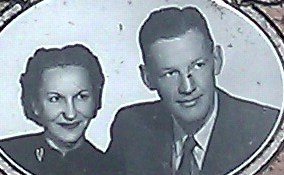
Betty MacDonald fan club honor member Mr. Tigerli is beloved all over the World.
We are so happy that our 'Casanova' is back.
I'd like to visit Betty MacDonald's magical place.
Best wishes,
Ina & Julia
 |
Don't miss this very special book, please.
Vita Magica
Betty MacDonald
Betty MacDonald fan club
Betty MacDonald forum
Wolfgang Hampel - Wikipedia ( English )
Wolfgang Hampel - Wikipedia ( English ) - The Egg and I
Wolfgang Hampel - Wikipedia ( Polski)
Wolfgang Hampel - Wikipedia ( German )
Wolfgang Hampel - LinkFang ( German ) Wolfgang Hampel - Academic ( German )
Wolfgang Hampel - cyclopaedia.net ( German )
Wolfgang Hampel - DBpedia ( English / German )
Wolfgang Hampel - people check ( English )
Wolfgang Hampel - Memim ( English )
Vashon Island - Wikipedia ( German )
Wolfgang Hampel - Monica Sone - Wikipedia ( English )
Wolfgang Hampel - Ma and Pa Kettle - Wikipedia ( English )
Wolfgang Hampel - Ma and Pa Kettle - Wikipedia ( French )
Wolfgang Hampel - Mrs. Piggle-Wiggle - Wikipedia ( English)
Wolfgang Hampel in Florida State University
Betty MacDonald fan club founder Wolfgang Hampel
Betty MacDonald fan club interviews on CD/DVD
Betty MacDonald fan club items
Betty MacDonald fan club items - comments
Betty MacDonald fan club - The Stove and I
Betty MacDonald fan club groups
Betty MacDonald fan club organizer Linde Lund
Ian Millhiser
The chilling implications of the FBI’s latest attack on Hillary Clinton
Innocent until proven guilty, unless someone in the FBI doesn’t like you.

Imagine
that you recently dated a cop, and then, after an acrimonious breakup,
the press started reporting that you are the subject of some kind of
criminal investigation.
Or
suppose that you have an ongoing dispute with a neighbor over a tree
that encroaches from his property into yours. The neighbor works in law
enforcement, and he starts spreading rumors to your other neighbors that
you are engaged in criminal activity.
Or imagine that you just interviewed for a job,
and the local police chief contacts your potential employer to let them
know that the police are investigating some vague misconduct you might
have committed in the past.
A law enforcement agency does not need to arrest you or charge you with a crime to disrupt your life. It can simply release innuendo into the wild.
Information
is power, even if that information is false or misleading. A law
enforcement agency does not need to arrest you or charge you with a
crime to disrupt your life. It can simply release innuendo into the wild
and watch your reputation — along with, potentially, your professional
and social life — collapse.
Which, of course, is what various individuals within the FBI are doing to Hillary Clinton.
FBI
Director James Comey’s decision to release damaging and vague
information to Clinton’s enemies last Friday is, as I argued on Monday, a firing offense.
As one former Justice Department official told the New Yorker’s Jane
Mayer, such a disclosure — especially because it appears to be based
entirely on speculation and conjecture— “impugns the integrity and reputation of the candidate, even though there’s no finding by a court, or in this instance even an indictment.”
The
FBI is not allowed to lay waste to a candidate’s reputation based on
little or no evidence. Just so we are clear, there is a policy that Comey violated prohibiting disclosures relating to political candidates.
Yet
Comey is hardly the only member of the FBI who doesn’t believe this
rule applies to him. Wednesday evening, the Wall Street Journal published leaked information
about an entirely separate investigation into former Secretary Clinton.
One of the reporters on this story is Devlin Barrett, who Talking
Points Memo’s Josh Marshall described as “the chief conduit of choice for anti-Clinton agents at the FBI.” And the details of this Clinton probe are almost too comic to be believed.
In 2015, Peter Schweizer, a reporter with the white nationalist site Breitbart News,
published a book called “Clinton Cash” which alleged that President and
Secretary Clinton used foreign connections to enrich themselves. The
CEO of Republican presidential candidate Donald Trump’s campaign,
Stephen Bannon, is the executive chairman of Breitbart.
Based
on this book, which was published by a writer at a white nationalist
site with close ties to the Trump campaign, some agents within the FBI
reportedly decided to investigate Clinton. Schweizer was himself
interviewed several times by these agents.
According
to the Wall Street Journal, representatives from the FBI met with
public integrity prosecutors and the head of the Department of Justice’s
criminal division in February. The prosecutors reportedly were not
impressed with this Breitbart-fueled investigation, and the DOJ
instructed the FBI to “stand down.”
And yet, the agents persisted, even as senior executives within the FBI turned against them.
Under
ordinary circumstances, this would have been nothing more than a
headache for the prosecutors and senior FBI officials faced with
insubordinate agents. But news of this probe is now public, in violation
of Justice Department policy. And the anti-Clinton forces within the
FBI appear to be doing their damnedest to maximize the damage this probe
inflicts on Clinton. As former DOJ spokesperson Matthew Miller
summarized the facts:
It appears that the FBI’s anti-Clinton faction is not limiting its leaks to the Wall Street Journal. On Fox News Wednesday night,
anchor Bret Baier claimed that “two separate sources with intimate
knowledge of what’s going on with these FBI investigations” told him an
indictment in the “Clinton Cash” investigation is likely, “barring some
obstruction in some way.” It is unclear how such an indictment would be
secured without the cooperation of prosecutors who have already decided
the Breitbart probe is meritless.
The
leaks regarding the FBI’s Breitbart probe, along with Comey’s letter to
Republican committee chairs, fit a larger pattern of the FBI spreading
incomplete information that is damaging to Secretary Clinton.
An internal FBI office will investigate
the FBI’s decision to tweet out documents regarding President Clinton’s
controversial Marc Rich pardon — an investigation the FBI closed more
than a decade ago. Similarly, on Monday, a series of news stories
suggested that there might be a direct connection between Trump and the
Russian government. Shortly after these stories were published, unnamed
“law enforcement officials” helped contain the damage to Trump
by telling the New York Times that they have not “found any conclusive
or direct link between Mr. Trump and the Russian government.”
It
is difficult, in other words, to escape the impression that a faction
within the FBI is actively trying to elect Mr. Trump and to weaken
Secretary Clinton. It appears to be doing so, moreover, in violation of
Justice Department policy, and in violation of the basic principle that
law enforcement should not spread rumors and innuendo in order to damage
people they do not like.
Home

‘Anybody can have tuberculosis…’
2 Replies
THE PLAGUE AND I, by Betty MacDonald, originally published in in the UK in 1948, my edition 1959
(boy, do I love old Penguins)…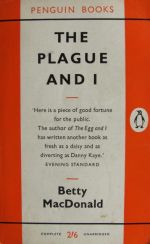 One of my favourites, for years and years. I can’t remember when I first encountered The Plague and I,
but certain expressions and catchphrases from it have passed into our
family shorthand, so my guess is that my parents loved it
too.’Toecover’, for instance, a word that describes a hand-made object
of uncertain usage and all-too-certain unpleasantness. Ideally, a
toecover should have no discernible function, and – in my opinion –
involve limp crochet in some respect. Then there’s ‘Hush ma mouth, what
have ah said?’, delivered in a clichéd Southern accent. This should be
deployed after the ostensibly inadvertent revelation of some fact that
has got the speaker into trouble, and is ironically directed at the
person who has given the game away. Then – no, enough already. You get
the idea.
This should not be a funny book. Absolutely not, no way, it’s about a
stay in a 1930s tuberculosis sanatorium, for heaven’s sake – and yet it
is. Hilarious, even laugh-out-loud funny in parts, and yet those parts
are interspersed with more serious stuff. I recently lent it to a friend
who had to spend some time in hospital, and she not only loved it,
finding it funny too, but also found it relevant. As she said, ‘times
change, but people don’t.’
One of my favourites, for years and years. I can’t remember when I first encountered The Plague and I,
but certain expressions and catchphrases from it have passed into our
family shorthand, so my guess is that my parents loved it
too.’Toecover’, for instance, a word that describes a hand-made object
of uncertain usage and all-too-certain unpleasantness. Ideally, a
toecover should have no discernible function, and – in my opinion –
involve limp crochet in some respect. Then there’s ‘Hush ma mouth, what
have ah said?’, delivered in a clichéd Southern accent. This should be
deployed after the ostensibly inadvertent revelation of some fact that
has got the speaker into trouble, and is ironically directed at the
person who has given the game away. Then – no, enough already. You get
the idea.
This should not be a funny book. Absolutely not, no way, it’s about a
stay in a 1930s tuberculosis sanatorium, for heaven’s sake – and yet it
is. Hilarious, even laugh-out-loud funny in parts, and yet those parts
are interspersed with more serious stuff. I recently lent it to a friend
who had to spend some time in hospital, and she not only loved it,
finding it funny too, but also found it relevant. As she said, ‘times
change, but people don’t.’
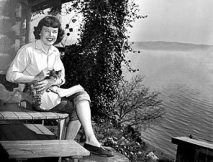
In the late 1930s Betty MacDonald – who had led a slightly unconventional life but who had, as yet, not committed any of it to paper (her best-known book is probably The Egg and I, about her first marriage to a chicken farmer and which came out in 1945) – developed a series of colds, then a cough, then extreme tiredness… But, ‘operating under the impression that I was healthy and that everyone who worked felt the same as I did’, failed to put two and two together. In all fairness, so did a series of doctors (largely because she consulted each specialist about his – and I mean his – own area), until she was finally diagnosed with TB. Tuberculosis, of course, could be tantamount to a death sentence. As it can now, sometimes – but then there were no drugs which worked against it and it was horribly prevalent. It’s also highly contaigious and MacDonald caught hers from a co-worker who managed to infect several other people as well. As a single mother with two small children and a negligible income, she was luckily admitted to a charitable sanatorium in Seattle, which she calls ‘The Pines’ in the book. She was to stay at Firland Sanatorium for nine months, in 1937-8, and emerged cured.
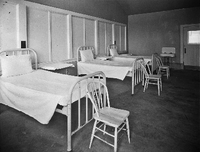
The picture she creates is so vivid that this is one of those books where the mental images generated are so strong that they dominate even when you see contradictory pictures of the place that inspired them. The echoing, draughty corridors, the never-ending cold, the sound of invisible footsteps approaching, passing and then fading into the distance… but it’s not depressing, even in the serious phases. It’s populated by a cast of characters, all of whom I find exceptionally well drawn and entertaining. They range from Betty’s family and her near-constant companion in The Pines, Kimi Sanbo, to the miscellaneous array of nurses and other patients such as Gravy Face and Granite Eyes (two nurses); Charlie who loved to pass on depressing news of deaths and disasters; Minna of the Southern drawl and ability to dump people in the cacky… there are so many of them, so well delineated, that picking just a few to mention here was difficult. But space has to be made for Miss Gillespie of the Ambulant Hospital’s occupational therapy shop, generator of many a toecover:

Mr. Tigerli in China
Copyright 2016 by Letizia Mancino
translation by Mary Holmes
All rights reserved













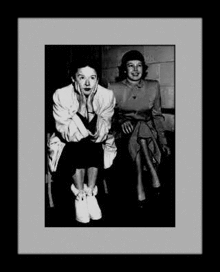


(boy, do I love old Penguins)…
 One of my favourites, for years and years. I can’t remember when I first encountered The Plague and I,
but certain expressions and catchphrases from it have passed into our
family shorthand, so my guess is that my parents loved it
too.’Toecover’, for instance, a word that describes a hand-made object
of uncertain usage and all-too-certain unpleasantness. Ideally, a
toecover should have no discernible function, and – in my opinion –
involve limp crochet in some respect. Then there’s ‘Hush ma mouth, what
have ah said?’, delivered in a clichéd Southern accent. This should be
deployed after the ostensibly inadvertent revelation of some fact that
has got the speaker into trouble, and is ironically directed at the
person who has given the game away. Then – no, enough already. You get
the idea.
This should not be a funny book. Absolutely not, no way, it’s about a
stay in a 1930s tuberculosis sanatorium, for heaven’s sake – and yet it
is. Hilarious, even laugh-out-loud funny in parts, and yet those parts
are interspersed with more serious stuff. I recently lent it to a friend
who had to spend some time in hospital, and she not only loved it,
finding it funny too, but also found it relevant. As she said, ‘times
change, but people don’t.’
One of my favourites, for years and years. I can’t remember when I first encountered The Plague and I,
but certain expressions and catchphrases from it have passed into our
family shorthand, so my guess is that my parents loved it
too.’Toecover’, for instance, a word that describes a hand-made object
of uncertain usage and all-too-certain unpleasantness. Ideally, a
toecover should have no discernible function, and – in my opinion –
involve limp crochet in some respect. Then there’s ‘Hush ma mouth, what
have ah said?’, delivered in a clichéd Southern accent. This should be
deployed after the ostensibly inadvertent revelation of some fact that
has got the speaker into trouble, and is ironically directed at the
person who has given the game away. Then – no, enough already. You get
the idea.
This should not be a funny book. Absolutely not, no way, it’s about a
stay in a 1930s tuberculosis sanatorium, for heaven’s sake – and yet it
is. Hilarious, even laugh-out-loud funny in parts, and yet those parts
are interspersed with more serious stuff. I recently lent it to a friend
who had to spend some time in hospital, and she not only loved it,
finding it funny too, but also found it relevant. As she said, ‘times
change, but people don’t.’
In the late 1930s Betty MacDonald – who had led a slightly unconventional life but who had, as yet, not committed any of it to paper (her best-known book is probably The Egg and I, about her first marriage to a chicken farmer and which came out in 1945) – developed a series of colds, then a cough, then extreme tiredness… But, ‘operating under the impression that I was healthy and that everyone who worked felt the same as I did’, failed to put two and two together. In all fairness, so did a series of doctors (largely because she consulted each specialist about his – and I mean his – own area), until she was finally diagnosed with TB. Tuberculosis, of course, could be tantamount to a death sentence. As it can now, sometimes – but then there were no drugs which worked against it and it was horribly prevalent. It’s also highly contaigious and MacDonald caught hers from a co-worker who managed to infect several other people as well. As a single mother with two small children and a negligible income, she was luckily admitted to a charitable sanatorium in Seattle, which she calls ‘The Pines’ in the book. She was to stay at Firland Sanatorium for nine months, in 1937-8, and emerged cured.

The picture she creates is so vivid that this is one of those books where the mental images generated are so strong that they dominate even when you see contradictory pictures of the place that inspired them. The echoing, draughty corridors, the never-ending cold, the sound of invisible footsteps approaching, passing and then fading into the distance… but it’s not depressing, even in the serious phases. It’s populated by a cast of characters, all of whom I find exceptionally well drawn and entertaining. They range from Betty’s family and her near-constant companion in The Pines, Kimi Sanbo, to the miscellaneous array of nurses and other patients such as Gravy Face and Granite Eyes (two nurses); Charlie who loved to pass on depressing news of deaths and disasters; Minna of the Southern drawl and ability to dump people in the cacky… there are so many of them, so well delineated, that picking just a few to mention here was difficult. But space has to be made for Miss Gillespie of the Ambulant Hospital’s occupational therapy shop, generator of many a toecover:
‘Miss Gillespie was physically and
mentally exactly what you’d expect the producer of hand-painted paper
plates to be. She had a mouth so crowded with false teeth it looked as
if she had put in two sets … and her own set of rules. One of these
rules was that women patients could not use the basement lavatory
because “the men will see you go in there and know what you go
in there for”. Another forbade the pressing of men’s trousers by women,
on the grounds that such intimate contact with male garments was
unseemly.’
Betty MacDonald is extremely good at expressing the life of any closed
institution. The way the world narrows down; the way rumours (‘all based
on a little bit of truth’) start, expand and spread; the effect of
being thrown into involuntary contact with people you would normally
avoid, and the intensity of the resulting reactions. (‘…the major
irritation of all was my room-mate, who was so damned happy all the
time, so well adjusted. She loved the institution and the institution
loved her. She loved all the nurses and the nurses loved her. She loved
all the other patients and all the other patients, but one, loved her.
That one used to lie awake in the long dark cold winter nights and
listen hopefully for her breathing to stop.’) It was a tough
regime, but it had to be – no drugs, remember. TB was essentially
treated by rest and some basic chest operations; there had to be rules.
But there was also the pointless expression of power indulged in by
some: ‘ “We do not tell the patients the rules, Mrs Bard. We find
that trial and error method is the best way to learn them.” I said, “But
how can I be obedient, co-operative, and helpful if I don’t know what
I’m supposed to do?” She said, “We don’t allow arguing, Mrs Bard”…‘
She is also very good on how difficult it is to adapt to life
afterwards, describing what could almost be a type of Stockholm
Syndrome. But she did shake herself free, and the TB didn’t reappear.
So yes, a sort of happy ending. ‘Sort of’ because Betty MacDonald
died in 1958, from cancer, at the age of only 50. I’m sure she would
have been surprised and possibly flattered to know that people were
still enjoying her books over fifty years later. I most certainly am.
Great book.
Mr. Tigerli in China
Copyright 2016 by Letizia Mancino
translation by Mary Holmes
All rights reserved
Yes Betty, either or it seems he wanted to fly only with
Singapore Airways.
Boeing or Airbus, it’s just the same
isn’t it? Aren’t they both just fat birds with 500 passengers?
Yes, but Singapore Airlines has the
most beautiful airhostesses: delicate, fine, graceful… Mr. Tigerli had looked forward to the flight
so much!
So the little man was disappointed?
You just can’t imagine how disappointed
he was.
But thank God one of the hostesses was a
pretty Chinese girl. Mr. Tigerli purred loudly but she didn’t hear him because
the purring of the Airbus 380 was even louder.
The poor cat!
You’ve said it Betty. Mr. Tigerli was
in a very bad mood and asked me for a loud speaker.
I’m sure you can get one in 1st
Class.
“”Russian Girl” had even heard you over
the roar of the Niagara Falls” I said to Mr. Tigerli. “You are a very
unfaithful cat. You wanted to get to know Asiatic girls. That’s how it is when
one leaves one’s first love”.
And what did he say to that?
“Men are hunters” was his answer.
Yes, my dear cat, a mouse hunter. And
what else did he say?
Not another word. He behaved as if he
hadn’t heard me.
The Airbus is very loud.
I told him shortly “Don’t trouble
yourself about “Chinese Girl”. There will be enough even prettier girls in
China. Wait till we land in Guilin”.
Did he understand you?
Naturally Mr. Tigerli understood me
immediately. Yes, sweetheart, don’t worry. They will find you something sweet
to eat.
And he?
He was so happy.
No problem going through the immigration
control?
Naturally! Lots of problems. How could I explain to
customs that the cat had come as a tourist to China to buy shoes?
Fur in exchange for shoes…
Don’t be so cynical Betty!
Cat meat in exchange for shoes?
He came through the pass control with
no trouble!

Is this Mr. Tigerli?











 |















